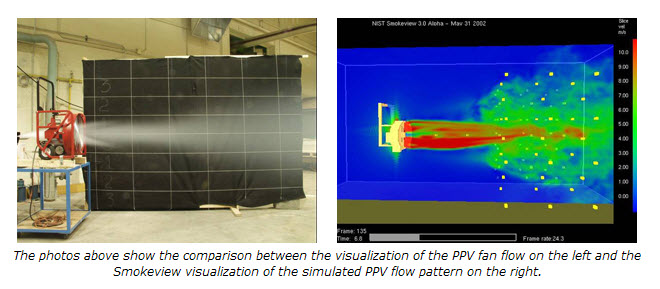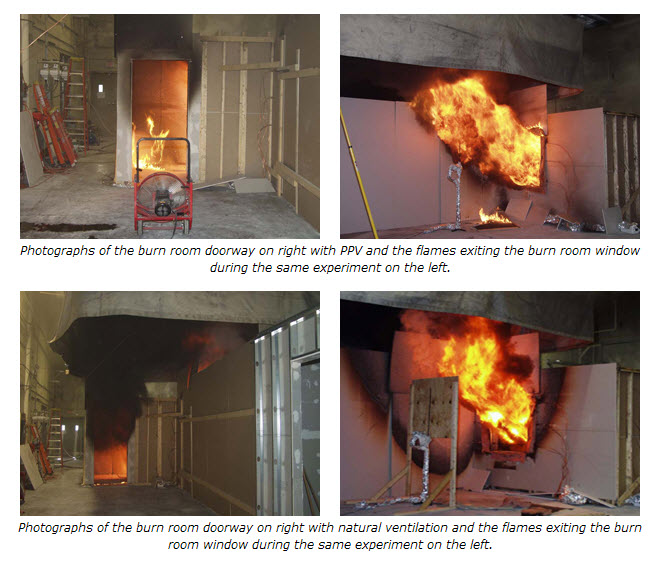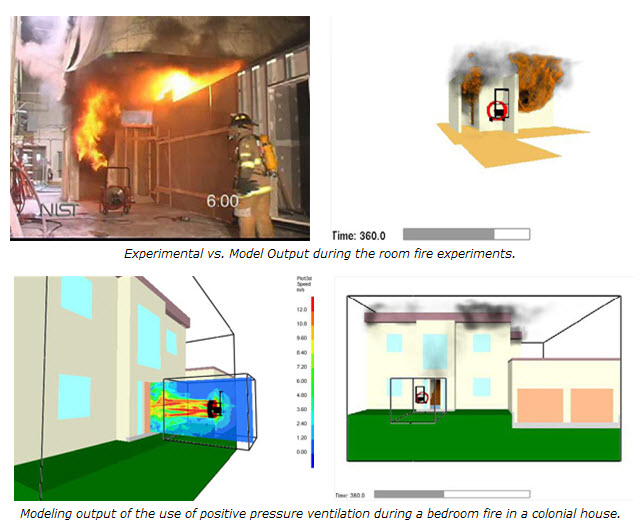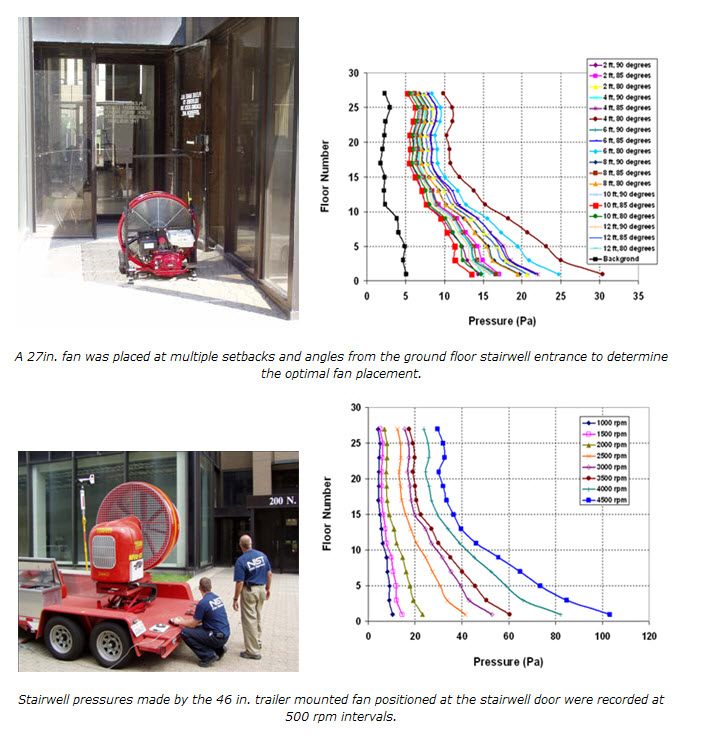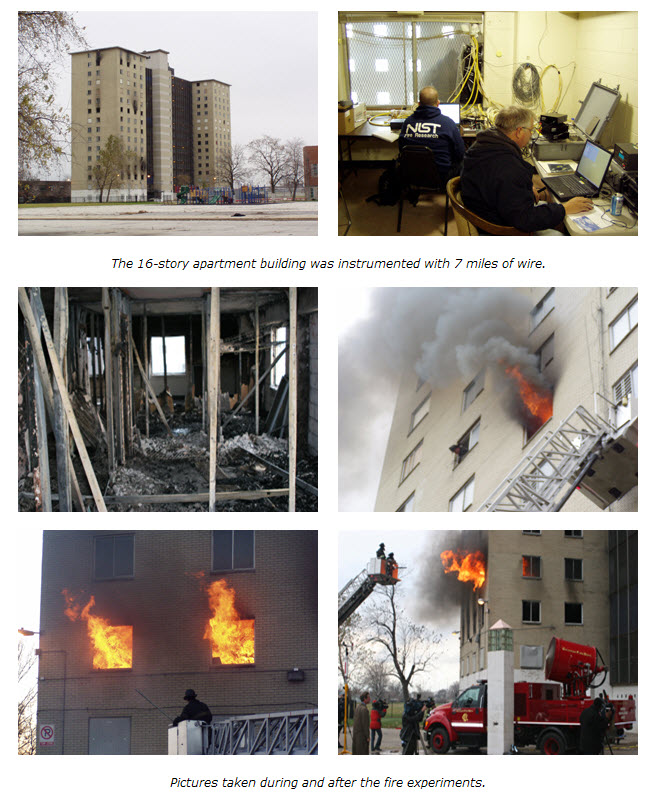Positive Pressure Ventilation Research
By Christopher J. Naum, SFPE on Jan 14, 2011 with Comments 0
 Positive Pressure Ventilation
Positive Pressure Ventilation
The objective of this NIST research is to improve firefighter safety by enabling a better understanding of structural ventilation techniques, including positive pressure ventilation (PPV) and natural ventilation, and to provide a technical basis for improved training in the effects of ventilation on fire behavior by examining structural fire ventilation using full-scale fire experiments with and without PPV using the NIST Fire Dynamics Simulator (FDS).
Characterizing Positive Pressure Ventilation using Computational Fluid Dynamics
Full-scale experiments were conducted by the NIST to characterize a Positive Pressure Ventilation (PPV) fan, in terms of velocity. Experiments were performed in an open atmosphere and in a simple room geometry. The results of the experiments were compared with Fire Dynamic Simulator (FDS) output. The measurements of both sets of experiments compare favorably with the FDS model results. With the correct geometry, vent placement, and boundary location FDS predicted velocities that were within 10 percent for the open atmosphere and 20 percent for the simple room geometry. The Smokeview visualization of the FDS results of the PPV fan’s flow pattern, and the flow out of the window also correlated well with those measured experimentally.
REPORT
Characterizing Positive Pressure Ventilation Using Computational Fluid Dynamics Kerber, S.; Walton, W. D., NIST Interagency/Internal Report (NISTIR) – 7065, February 2003
VIDEO
Smokeview PPV.avi (A short Smokeview clip of the simulated PPV fan; 3 MB)
Effect of Positive Pressure Ventilation on a Room Fire
Fire departments may use ventilation blowers or fans to pressurize a structure prior to suppressing a fire. This pressurization or positive pressure ventilation (PPV) tactic can assist in the venting of smoke and high temperature combustion products and make attacking the fire easier than without PPV. However, this tactic also provides additional oxygen to the fire and can increase the rate of heat and energy being released. PPV has not been characterized carefully enough to establish specific guidelines for optimum use.
This study examined gas temperatures, gas velocities and total heat release rate in a series of fires in a furnished room. The use of the PPV fan created slightly lower gas temperatures in the fire room and significantly lower gas temperatures in the adjacent corridor. The gas velocities at the window plane were much higher in the PPV case than in the naturally ventilated scenario. This higher velocity improved visibility significantly. PPV caused an increase in heat release rate for 200 seconds following initiation of ventilation but the heat release rate then declined at a faster rate than that of the naturally ventilated experiment.
REPORT
Effect of Positive Pressure Ventilation on a Room Fire NISTIR 7213; 54 p. March 2005. Kerber, S.; Walton, W.
VIDEOS
Video Natural.wmv (4 views of a naturally ventilated experiment in 5x speed; 19 MB)
Video PPV.wmv (4 views of an experiment ventilated by PPV in 5x speed; 19 MB)
Upper Photographs of the burn room doorway on right with PPV and the flames exiting the burn room window during the same experiment on the left.
Lower Photographs of the burn room doorway on right with natural ventilation and the flames exiting the burn room window during the same experiment on the left.
Evaluation of the Ability of Fire Dynamics Simulator to Simulate Positive Pressure Ventilation in the Laboratory and Practical Scenarios
This report, which incorporates information from Characterizing Positive Pressure Ventilation using Computational Fluid Dynamics and Effect of Positive Pressure Ventilation on a Room Fire reports, also compares data from three full-scale Positive Pressure Ventilation (PPV) experiments with simulations completed using the Fire Dynamics Simulator (FDS). All experiments qualify and quantify the comparison of the experimental results with the FDS results. A concluding scenario is modeled utilizing the calibration of the full-scale experiments to examine the effects of PPV on a fire in a two-story, colonial style house.
REPORT
Evaluation of the Ability of Fire Dynamic Simulator to Simulate Positive Pressure Ventilation in the Laboratory and Practical Scenarios Kerber, S., April 2006, NIST Interagency/Internal Report (NISTIR) – 7315
VIDEO
Two 4-view FDS simulations of a naturally ventilated experiment and a PPV ventilated experiment. The videos are simulating the experiments documented in the “Effect of Positive Pressure Ventilation on a Room Fire.” Simulation details are in the above report.
FDS Natural.wmv (10 MB)
FDS PPV.wmv (9 MB)
Full-Scale Evaluation of Positive Pressure Ventilation in a Firefighter Training Building
A series of full-scale experiments was conducted in a three-story firefighter training burn building to compare natural ventilation with positive pressure ventilation (PPV). A wood pallet and dry hay fire were allowed to burn in the structure with all doors and windows closed until the fire reached an oxygen-limited state. A door and window were then opened. The structure was ventilated naturally or with a positive pressure fan placed at the front door. Fourteen different configurations of fire room and vent locations were examined, each with both natural and positive pressure ventilation. Gas temperatures, air velocities, fire room oxygen concentrations and differential pressures were recorded and compared for the different configurations and ventilation techniques.
The data indicate that, with both natural and positive pressure ventilation techniques, using correct ventilation scenarios resulted in lower temperatures within the structure at the 0.61 m (2 ft) height, where victims may have been located, and at the 1.22 m (4 ft) height, where firefighters may have been operating. There were only limited ventilation configurations where the temperatures in rooms other than the fire room exceeded the victim or firefighter threshold temperatures with either ventilation technique. The use of positive pressure ventilation resulted in visibility improving more rapidly and, in many cases, cooled rooms surrounding the fire room. However, the use of positive pressure ventilation also caused the fire to grow more quickly, and in some cases, created higher temperatures at the lower elevations within the structure. Overall, this limited series of experiments suggests that PPV can assist in making the environment in the structure more conducive for firefighting operations.
REPORT
Full-Scale Evaluation of Positive Pressure Ventilation In a Fire Fighter Training Building Kerber, S.; Walton, W. D., July 2006, NIST Interagency/Internal Report (NISTIR) – 7342
VIDEO
The video shows a 4-view comparison of one of the above documented experiments. The left 2-views show an interior and exterior view of a naturally ventilated fire and the right two views show the same views of a PPV ventilated fire. The video is 4-times real speed.
Kerber1_4x.mpg (41 MB)
Evaluating Positive Pressure Ventilation In Large Structures: High-rise Pressure Experiments
One hundred and sixty experiments were conducted in a thirty-story vacant office building in Toledo, Ohio to evaluate the ability of fire department positive pressure ventilation fans to pressurize a stairwell in a high-rise structure to the performance metrics established for fixed stairwell pressurization systems. Variables such as fan size, fan angle, setback distance, number of fans, orientation of fans, number of doors open and location of vents open were altered to examine capability and optimization of each. Fan size varied from 0.4 m (16 in) to 1.2 m (46 in). Fan angle ranged from 90 degrees to 80 degrees. The setback distance went from 0.6 m (2 ft) to 3.6 m (12 ft). Between one and nine fans were used and fans were located at three different exterior locations and three different interior locations. Fans were oriented in both series and in parallel. Doors throughout the building were opened and closed to evaluate the effects. Finally a door to the roof and a roof hatch were used as vent points to evaluate the effects. The measurements taken during the experiments included differential pressure, air temperature, carbon monoxide, metrological data and sound levels.
PPV fans utilized correctly can increase the effectiveness of fire fighters and survivability of occupants in high-rise buildings. In a high-rise building it is possible to increase the pressure of a stairwell to prevent the infiltration of smoke if fire crews configure the fans properly. Many variables need to be taken into account to achieve stairwell pressures that are high enough to meet or exceed the performance metrics for fixed smoke control systems.
REPORT
Evaluating Positive Pressure Ventilation In Large Structures: High-Rise Pressure Experiments Kerber, S.; Madrzykowski, D.; Stroup, D. W., March 2007, NIST Interagency/Internal Report (NISTIR) – 7412
VIDEO
The clip shows the Toledo media coverage during the experiments.
Toledo in The News.mpg
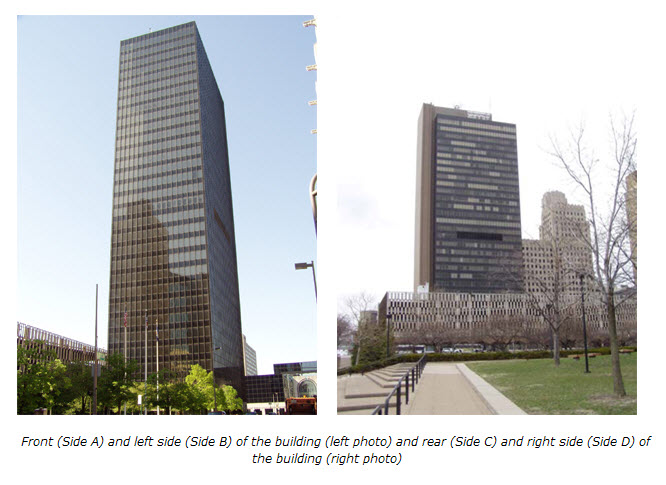
Evaluating Positive Pressure Ventilation In Large Structures: High-rise Fire Experiments
The National Institute of Standards and Technology (NIST), in cooperation with the Chicago Fire Department and the Chicago Housing Authority, conducted a series of fire experiments in a 16 story high rise. The purpose of the experiments was to improve the safety of fire fighters and building occupants by enabling a better understanding of structural ventilation techniques using positive pressure ventilation (PPV) fans in large buildings.
10 NIST technical staff members worked side by side with more than 70 CFD staff in preparing and instrumenting the building for the experiments. Several rooms were furnished and burned on the 15th, 10th and 3rd floors. The pressure and temperature on each floor was monitored. Temperature and heat flux measurements were made on the fire floors to characterize the thermal environment that firefighters work in.
Observations on the scene demonstrated the positive impact that the fans can have in reducing the temperatures and the amount of smoke outside of the rooms that are involved in fire. The final analysis of the results are scheduled for completion in Spring on 2007.
Other fire departments that participated in the experiments included: Delaware County Emergency Services (PA), New York (NY), Ottawa (Canada) and Toledo (OH). Underwriters Laboratories made measurements on smoke detector activation in the corridors during the experiments. The experiments were sponsored in part by the U.S. Department of Homeland Security. Three major fan manufacturers also participated in the experiments.
REPORT
Evaluating Positive Pressure Ventilation In Large Structures: High-Rise Fire Experiments Kerber, S.; Madrzykowski, D.; November 2007, NIST Interagency/Internal Report (NISTIR) – 7468
VIDEOS
Clip 1 is a stairwell view looking at the fire floor doorway on the 15th floor. Two 27 in. portable fans are pressurizing the stairwell (1 at the base of the stairwell and 1 on the 13th floor) and keeping the smoke out. The fans are cycled on and off to show the effects. Clip 2 shows a stairwell view on the 3rd floor after the stairwell is full of smoke. A truck mounted fan is turned on to vent the stairwell. Clip 3 shows an exterior view of the truck mounted fan creating a wind driven fire. Clip 4 is an interior 4-view of the wind driven fire documented as the Experiment in apartment 304. The News clip shows the media coverage during the experiments.
Chicago Clip 3_304exterior.mpg (12 MB)
Chicago Clip 2_303stair.mpg (19 MB)
Chicago Clip 1_1505stair.mpg (14 MB)
Wind_4view.wmv (210 MB)
Chicago News.mpg (127 MB)
Evaluating Positive Pressure Ventilation In Large Structures: School Pressure and Fire Experiments
In June NIST traveled to Toledo, Ohio to further examine PPV with the Toledo Fire Rescue Department. A series of experiments was run in a building of opportunity examining the ability of PPV fans to limit smoke spread or to remove smoke from desired areas. The two main scenarios included a long hallway with classrooms and a gymnasium. Both scenarios included fires that produce a large amount of smoke and hot gases and instrumentation was placed to assess tenability criteria and how PPV tactics can either increase or decrease survivability. Measurements include temperature, oxygen concentration, CO concentration, pressure and numerous video views.
REPORT
Evaluating Positive Pressure Ventilation In Large Structures: School Pressure and Fire Experiments Kerber, S., July 2008, NIST Technical Note 1498
VIDEOS
Wired Science’s “Fired Up” — This link takes you to a program called Wired Science on PBS that focused part of an episode of their show on these experiments.
PPV Experiment Videos — Videos showing each experiment from 8 different views for the duration of each experiment. View report for camera locations, timelines and data that allow you to follow the changes taking place in the videos.
Filed Under: BuildingsonFire • Combat Fire Engagement • Research • Research Hub • Tactical Operations
